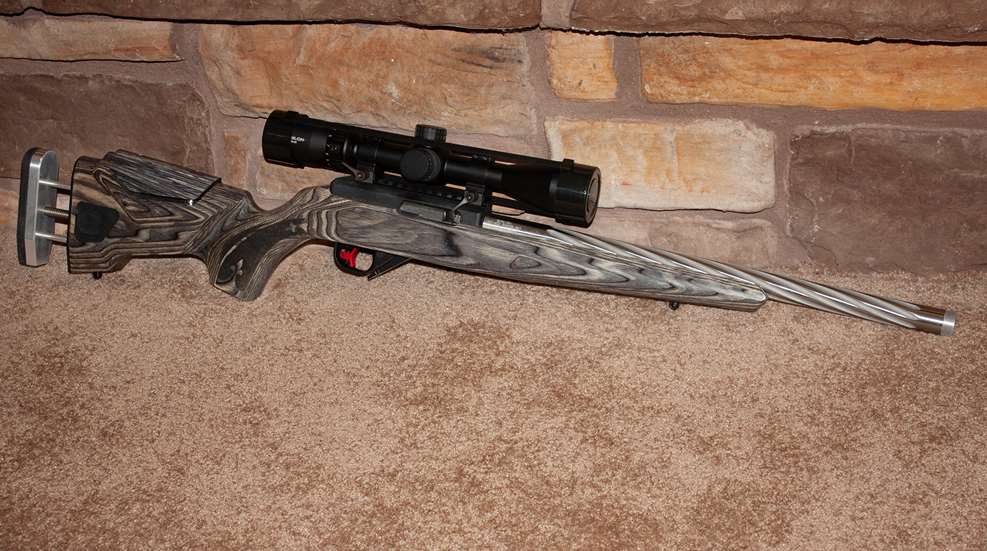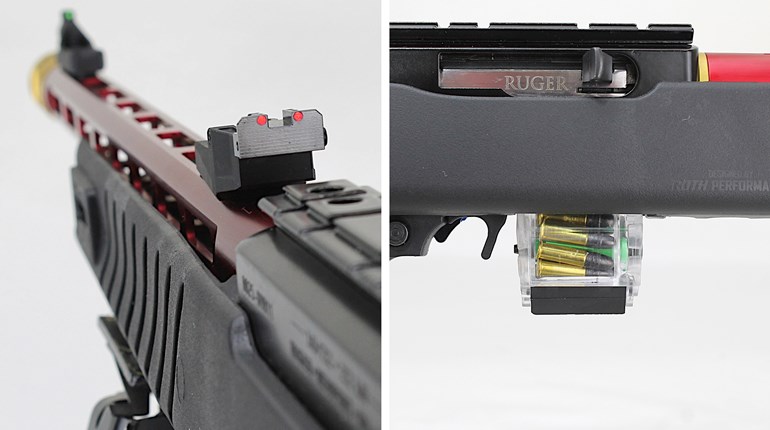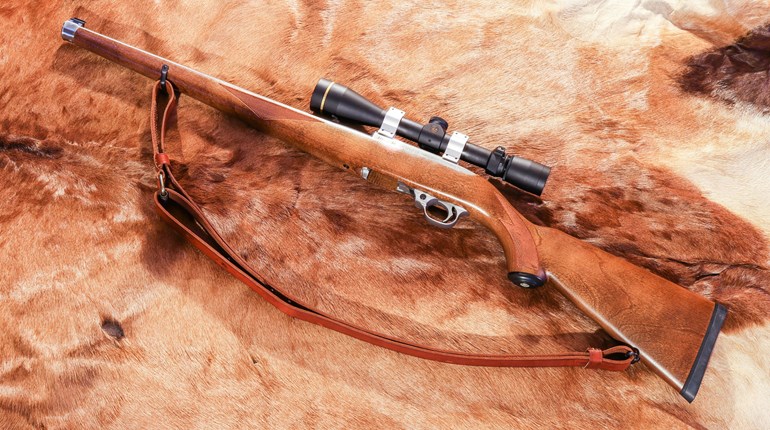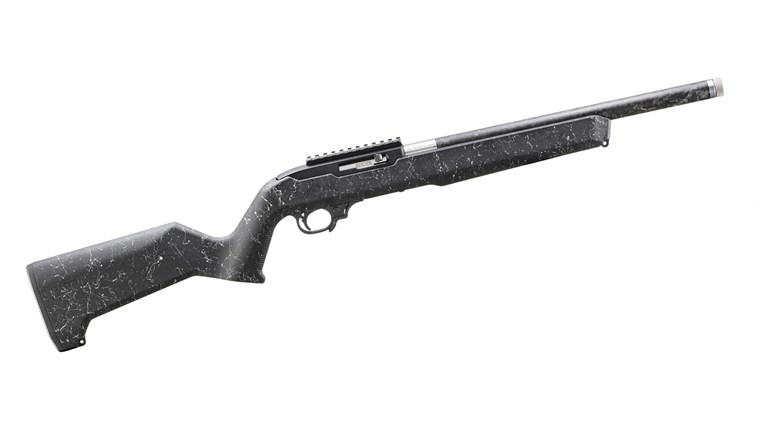
When it comes to rimfire rifles, I have a soft spot for the Ruger 10/22, though it wasn’t love at first sight. At seven years old when I began my education in firearms and marksmanship, this highly impressionable newcomer was instantly smitten by other’s firearms, namely the glossy curves of the likes of the Remington Nylon 66 and the modular takedown design of the ArmaLite AR-7. (Besides, James Bond used one to shoot down a helicopter, so that made it extra cool.) While my father wisely shared in my enthusiasm and encouraged me to have trigger time with anything new that came along, like an old friend, I always seemed to circle back to Ruger 10/22. It’s become a favorite, so much so that approximately six custom-built variants reside in the Boyd Bunker (with even more on the drawing board).
Given the enormous size of the platform’s aftermarket, I’m constantly being asked to review something new for Shooting Illustrated. Such was the case when I was approached by a friend in the firearm industry about a new model of Boyds’ Gunstock named the Agility. Despite sharing the same name, in the interest of full disclosure I am no affiliation and/or relation. Moreover, in my nearly 15 years as a gunwriter, I’m ashamed to say I’ve had hardly any experience with the company’s products. It was a shortcoming I eagerly looked forward to rectifying. The Ruger 10/22 seemed to be a no brainer, and the likelihood of Agility not being offered for the 10/22 is right up there with Hollywood announcing a sequel to “Waterworld.” Furthermore, with the ample supply of other related accessories I’ve amassed over the years for editorial coverage, this would present an excellent opportunity to assemble a truly one-of-a-kind, purpose-built firearm that—with a tad of luck—would stand apart from my other previous rimfires I’ve made.
One of the biggest things that sets Boyds’ Gunstocks apart from its competitors, is that it offers consumers a wide selection of high-quality hardwood gunstocks in solid-wood or laminate designs for more than 1,200 different gun models for in excess of 155 firearm brands. This American, family-owned business located in Mitchell, SD, since 1981 where it employs a staff of more than 100 skilled craftsmen.
The talented staff even take painstaking care to preserve whatever type of wood you select from the time it arrives at the facility, through the entire manufacturing process—up until the moment the stock ships.
Out of the several 10/22s in my collection, the majority of them wear polymer furniture. In addition to offering a quicker manufacturing process and budget-friendly prices, polymer stocks are lighter, offering significant weight-saving, while simultaneously being less prone to warping when compared to conventional wood. However, there are those who believe the same elements that make polymer a positive can also be viewed as a negative. Polymer’s cost-effectiveness and light weight notwithstanding, it’s easy to see how some can view it as a cheap material that lacks the character, uniqueness and quality associated with warm hues and delineated grain that only wood can provide. Upon realizing that only one of my 10/22s: the one my father started me shooting more than 40 years ago still wore its Walnut OEM stock. As such, Boyds’ newest Agility Gunstock would serve as an artful canvas right out of the gate. My goal? To create a 10/22 configured for hunting small game, with emphasis and accuracy and adaptability in the field.
I selected Pepper Laminate for my stock. The subtle pairing of gray with black accents offered a touch a touch of class while being equally eye pleasing. Meanwhile, from a design standpoint I suspected both colors would lend pair well with both stainless- and black-colored accessories/components. For an added element of custom flair Boyds also offers a wide selection of laser engraving, further allowing the consumer the ability to build their gun to suite their own individual needs and tastes. A lifelong fan of the Crescent City, I chose a Fleur de Lis laser pattern on the pistol grip and forearm paired with a non-aggressive yet purchase-enhancing textured stippling. While the company gives consumers the freedom of ordering a certain length-of-pull and comb height—which ultimately creates a rifle custom fit to the consumer—the Agility offers features that grant the end user even greater adaptability.
This addition the company’s line of stocks incorporates an adjustable buttpad from its popular At-One stock design, granting you the welcome flexibility by allowing you to fit the rifle to yourself or anyone else with the simple push of a button. Similarly, its Monte Carlo-style comb features an ambidextrous cheekpiece to help create the proper cheek weld. However, for those who prefer a tad more variety, an optional adjustable cheek comb is available. An Allen key allows you to make necessary changes on the fly while making the Agility more friendly to a variety of optics. Both features would be perfect in a hunting rifle as the length-of-pull could be easily modified to accommodate changes in clothing or different users.
The lower half of the stock features what Boyds calls a Hybrid Grip that is more vertical than a traditional gunstock, but not to the extent as a gun configured for professional or competitive shooter. The underside of the stock’s forearm also boasts a semi-beavertail shape that fits your hand quite well, providing a solid yet comfortable hold, even while wearing gloves. Having found the ideal stock for my small-game rifle, I focused on selecting complimentary components. MSRP for the Agility as I received it is $376 in the configuration as described.
Start With A Good Foundation
For the rifle’s receiver, I selected a railed BRN-22 stripped variant from Brownells. In addition to being precision-machined from 6061 aluminum billet to exacting tolerances, the BRN-22 receiver is fully compatible with all components that fit a factory Ruger 10/22—meaning consumers can select from the vast array of barrels, stocks, triggers and other custom components when planning their build. After machining, each BRN-22 receiver gets a tough matte-black Type II hard-coat anodized finish (similar to the finishes found on many AR-15 receivers) that blends with most barrel and 10/22 trigger-module finishes. Best of all, the BRN-22 features an integral Picatinny top rail for extra security and versatility when mounting optics, it ships with a V-block and screws for barrel installation and there’s even a pre-drilled cleaning-rod hole at the rear of each Brownells BRN-22 receiver for easy cleaning of the bore from the chamber—the proper way to prevent cleaning rod from damage to the muzzle crown that can compromise accuracy. Components wise, I outfitted the receiver with an OEM bolt, recoil spring and charging handle. (Word of warning: Even after assembling many of these rifles, the installation of the bolt and charging-handle assembly into the receiver is the most frustrating part of a 10/22 build. The folks at Tandemkross.com were kind enough to supply me with a Gunsmither 10/22 Bolt Bar, which made the process extremely easy—especially for a gimpy gunwriter with limited fine-motor skills and limited use of one hand. Tandemkross also supplied a pair of its Upgraded Receiver KrossPins and Upgraded Magazine Release KrossPins, each of which were super convenient and much easier to install than their OEM counterparts.) Concerning the barrel, I knew I whatever I selected had to deliver uncompromising accuracy.
Constructed from double-stress-relieved 18-inch, 416R stainless steel, the Shaw Barrels’ Ruger 10/22 Replacement Barrel boasts a .920-inch, bull-barrel contour that minimizes accuracy-robbing movement by adding mass where it is needed most. its Bentz chamber, while not as tight as a minimum-spec match chamber, it is significantly tighter than sporter variants. The result promises to help the shooter garner noticeably better accuracy with standard ammunition. In addition to selecting a stainless finish, the barrel I selected also boasted a threaded muzzles to accommodate either a brake or a sound suppressor. Helical flutes spanned almost the entire length while providing eye-catching aesthetics and aiding in barrel cooling. Stainless scope rings could add a touch of contrast. MSRP for the barrel I chose is $159.60.
When it came to selecting the rifle’s trigger, a Timney Trigger was a no-brainer and selected the Ruger 1022CE, Two Stage with Short Mag Release. Factory preset to deliver a single-stage, ultra-crisp, creep-free, 8-ounce pull and a 16-ounce second stage, this “bang switch” would allow me to get the most accuracy out of my rifle. It offers a drop-in, monolithic assembly that requires no gunsmithing and is easy to install. An extended magazine release that can be actuated with one hand is part of the unit, and customers can choose either a black or silver finish. MSRP: $299.99; timneytriggers.com
They say a rifle is only as good as its optic, and when it came time to select glass for this project the same industry contact who approached me regarding the Boyds’ Gunstock also suggested I go with Athlon Optics. Like Boyd’s, I had no experience with Athlon and agreed. The model I selected, was the NEOS 4-12×40 BDC. Specifically designed for a rimfire, this EOS 4-12x40mm scope comes with a host of features, like a 1-inch aircraft-grade aluminum tube, heat-treated, one-piece tube construction and fully multi-coated lenses. In addition, the EOS is shockproof and nitrogen is used to purge air from the optic to maintain its internal fog-proof and waterproof capabilities. Available in either an illuminated- or non-illuminated BDC 22 rimfire or BDC 500 IR reticles, the scope offers 3.11 to 3.15 inches of eye relief, 10 yards of parallax adjustment and 8.9 to 27.3 feet field-of-view at 100 yards. Its capped windage and elevation turrets feature .25-MOA adjustments. Best of all, the BDC reticle contains several stadia lines along the horizontal and vertical crosshairs to take the guess work out of determining proper holdover at various distances.
Athlon NEOS 4-12x40 BDC Specifications
- Magnification: 4-12X
- Objective Lens Diameter: 40mm
- Reticle: BDC 22 rimfire, Center X
- Length: 12.4 inches
- Weight: 18.1 ounces
- MSRP: $212.49
- (855) 913-5678; athlonoptics.com
If you’re considering a 10/22 build or upgrading to one with ergonomic enhancements, Boyd’s Agility gunstock will take your long gun to the next level and do so without breaking the bank.




































